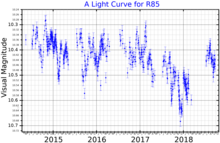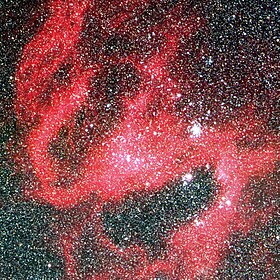R85
| 관측 정보 역기점 J2000 분점 J2000 | |
|---|---|
| 별자리 | 황새치자리 |
| 적경 | 05h 17m 56.076s[1] |
| 적위 | -69° 16′ 03.77″[1] |
| 겉보기등급 (V) | 10.84[2] (10.65 - 10.80[3]) |
| 특성 | |
| 진화 단계 | LBV[4] |
| 스펙트럼 종류 | B5 Iae[3] |
| 겉보기등급 (U) | 10.28[2] |
| 겉보기등급 (B) | 10.93[2] |
| 겉보기등급 (V) | 10.84[2] |
| 겉보기등급 (R) | 10.53[2] |
| 겉보기등급 (I) | 10.44[2] |
| 겉보기등급 (J) | 10.103[1] |
| 겉보기등급 (H) | 9.980[1] |
| 겉보기등급 (K) | 9.822[1] |
| U−B 색지수 | −0.65[2] |
| B−V 색지수 | +0.09[2] |
| 변광 종류 | LBV[4] |
| 위치천문학 | |
| 시선속도 (Rv) | 292[5] km/s |
| 고유운동 (μ) | RA: −1.0[6] mas/yr Dec.: −2.3[6] mas/yr |
| 거리 | 160,000 ly (50,000[7] pc) |
| 절대등급 (MV) | −8.2 – −8.5[3] |
| 상세 | |
| 1960 (최소) | |
| 반지름 | 135[8] R☉ |
| 광도 | 350,000[3] L☉ |
| 유효온도 | 13,500[3] K |
| 1983 - 1990 (최대) | |
| 광도 | 315,000[3] L☉ |
| 유효온도 | 10,000[3] K |
| 천체 명칭 | |
| 데이터베이스 자료 | |
| SIMBAD | 데이터 |
R85(또는 Radcliffe Observatory Magellanic Clouds catalog(래드클리프 천문대 마젤란운 목록)에서 따온 RMC 85[5])는 대마젤란 은하의 LH-41 OB 성협에 위치한 밝은 청색변광성 후보다.[9]

R85는 약 0.3등급의 진폭으로 밝기가 불규칙하게 변하는 것으로 나타났다. 여러 기간에 따른 변광을 보여 주며 때로는 뚜렷한 400일의 기간을 가지기도 한다. 또한 밝은 청색변광성의 특성인 수년에 걸친 밝기 변화와 관련된 온도 변화도 보였다.[11]
R85의 현재 특성과 진화 모델에 따르면 아마도 초기 질량은 28 M☉으로 시작했을 것이다.[12] 황새치자리 S와 함께 성운 LHA-120 N119에서 항성풍으로 DEM L132a라는 거품을 만드는 것으로 이론화되었습다.[13] 항성풍과 일치하는 적외선 과잉이 있다.[4]
각주[편집]
- ↑ 가 나 다 라 마 Cutri, Roc M.; Skrutskie, Michael F.; Van Dyk, Schuyler D.; Beichman, Charles A.; Carpenter, John M.; Chester, Thomas; Cambresy, Laurent; Evans, Tracey E.; Fowler, John W.; Gizis, John E.; Howard, Elizabeth V.; Huchra, John P.; Jarrett, Thomas H.; Kopan, Eugene L.; Kirkpatrick, J. Davy; Light, Robert M.; Marsh, Kenneth A.; McCallon, Howard L.; Schneider, Stephen E.; Stiening, Rae; Sykes, Matthew J.; Weinberg, Martin D.; Wheaton, William A.; Wheelock, Sherry L.; Zacarias, N. (2003). “VizieR Online Data Catalog: 2MASS All-Sky Catalog of Point Sources (Cutri+ 2003)”. 《CDS/ADC Collection of Electronic Catalogues》 2246: II/246. Bibcode:2003yCat.2246....0C.
- ↑ 가 나 다 라 마 바 사 아 Ducati, J. R. (2002). “VizieR Online Data Catalog: Catalogue of Stellar Photometry in Johnson's 11-color system”. 《CDS/ADC Collection of Electronic Catalogues》 2237. Bibcode:2002yCat.2237....0D.
- ↑ 가 나 다 라 마 바 사 Van Genderen, A. M. (2001). “S Doradus variables in the Galaxy and the Magellanic Clouds”. 《Astronomy and Astrophysics》 366 (2): 508–531. Bibcode:2001A&A...366..508V. CiteSeerX 10.1.1.459.5400. doi:10.1051/0004-6361:20000022. S2CID 55796300.
- ↑ 가 나 다 Bonanos, A. Z.; Massa, D. L.; Sewilo, M.; Lennon, D. J.; Panagia, N.; Smith, L. J.; Meixner, M.; Babler, B. L.; Bracker, S.; Meade, M. R.; Gordon, K. D.; Hora, J. L.; Indebetouw, R.; Whitney, B. A. (2009). “Spitzersage Infrared Photometry of Massive Stars in the Large Magellanic Cloud”. 《The Astronomical Journal》 138 (4): 1003–1021. arXiv:0905.1328. Bibcode:2009AJ....138.1003B. doi:10.1088/0004-6256/138/4/1003. S2CID 14056495.
- ↑ 가 나 Feast, M. W.; Thackeray, A. D.; Wesselink, A. J. (1960). “The brightest stars in the Magellanic Clouds”. 《Monthly Notices of the Royal Astronomical Society》 121 (4): 337. Bibcode:1960MNRAS.121..337F. doi:10.1093/mnras/121.4.337.
- ↑ 가 나 Høg, E.; Fabricius, C.; Makarov, V. V.; Urban, S.; Corbin, T.; Wycoff, G.; Bastian, U.; Schwekendiek, P.; Wicenec, A. (2000). “The Tycho-2 catalogue of the 2.5 million brightest stars”. 《Astronomy and Astrophysics》 355: L27. Bibcode:2000A&A...355L..27H.
- ↑ Aldoretta, E. J.; Caballero-Nieves, S. M.; Gies, D. R.; Nelan, E. P.; Wallace, D. J.; Hartkopf, W. I.; Henry, T. J.; Jao, W.-C.; Maíz Apellániz, J.; Mason, B. D.; Moffat, A. F. J.; Norris, R. P.; Richardson, N. D.; Williams, S. J. (2015). “The Multiplicity of Massive Stars: A High Angular Resolution Survey with the Guidance Sensor”. 《The Astronomical Journal》 149 (1): 26. arXiv:1410.0021. Bibcode:2015AJ....149...26A. doi:10.1088/0004-6256/149/1/26. S2CID 58911264.
- ↑ Stahl, O.; Wolf, B.; Leitherer, C.; Zickgraf, F.-J.; Krautter, J.; De Groot, M. (1984). “Variable blue supergiants in the Large Magellanic Cloud - R 84, R 85, and R 99”. 《Astronomy and Astrophysics》 140: 459. Bibcode:1984A&A...140..459S.
- ↑ Richardson, Noel D.; Mehner, Andrea (2018). “The 2018 Census of Luminous Blue Variables in the Local Group”. 《Research Notes of the American Astronomical Society》 2 (3): 121. arXiv:1807.04262. Bibcode:2018RNAAS...2..121R. doi:10.3847/2515-5172/aad1f3. S2CID 119509358.
- ↑ “ASAS-SN Variable Stars Database”. 《ASAS-SN Variable Stars Database》. ASAS-SN. 2022년 1월 6일에 확인함.
- ↑ Van Genderen, A. M.; Sterken, C.; De Groot, M. (1998). “Light variations of massive stars (alpha Cyg variables). XVI. The LMC supergiants R 85 (LBV) and R 110 (LBV) and the SMC supergiants R 42 and R 45”. 《Astronomy and Astrophysics》 337: 393. Bibcode:1998A&A...337..393V.
- ↑ Smith, Nathan; Tombleson, Ryan (2015). “Luminous blue variables are antisocial: Their isolation implies that they are kicked mass gainers in binary evolution”. 《Monthly Notices of the Royal Astronomical Society》 447 (1): 598–617. arXiv:1406.7431. Bibcode:2015MNRAS.447..598S. doi:10.1093/mnras/stu2430. S2CID 119284620.
- ↑ Ambrocio-Cruz, P.; Rosado, M.; Laval, A.; Le Coarer, E.; Russeil, D.; Amram, P. (2008). “Kinematic field of the S-shaped nebula N119 in the LMC”. 《Revista Mexicana de Astronomía y Astrofísica》 44: 355. Bibcode:2008RMxAA..44..355A.

